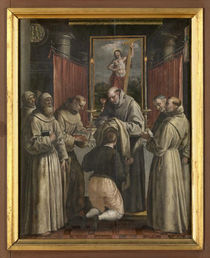The Catholic Defender: Saint Titus Brandsma
- Donald Hartley

- Jul 27
- 4 min read
Updated: Jul 28
Deepertruth with special permission and aid with Franiciscan Media, a great team for the Lord

Given the birth name Anno, Brandsma and his siblings grew up on their parents’ dairy farm in rural Frisia. As devout Catholics, the family was in the minority among their Calvinist neighbors. From age 11 Anno was educated at a preparatory school for boys who were studying for the priesthood. He joined the Carmelite novitiate in 1898, taking the name Titus in honor of his father.
In the years following his 1905 ordination, Brandsma received a doctorate in philosophy and initiated a project to translate the works of Saint Teresa of Avila into Dutch. One of the founders of the Catholic University of Nijmegen, he served as a professor of philosophy and the history of mysticism at the school. While there Brandsma was known more for his availability to faculty and students than for his academic achievements.
As a journalist, Brandsma was fearless. He spoke out when it seemed everyone else was quietly looking the other way. He was willing to stand alone against a government that resisted the will of the people. When he lived and worked in the Netherlands during the 1930s and ’40s, social media had not yet developed. What Pope John Paul II called the “digital continent” — that new way of communicating across borders — was the stuff of imagination. Still, Titus Brandsma, a priest of the Carmelite order and a journalist, managed to communicate widely with the Dutch faithful. He served as editor of his local newspaper and as ecclesiastical adviser to Catholic journalists at some 30 Dutch newspapers.

Working as a journalist Brandsma served as ecclesiastical advisor to Catholic journalists. His long-standing opposition to Nazi ideology came to the attention of the Nazis when they invaded the Netherlands in 1940. In direct opposition to the Third Reich, the Conference of Dutch Bishops sent a letter ordering Catholic newspaper editors not to print Nazi propaganda. Fr. Brandsma was arrested while hand delivering the letter in January 1942. After being imprisoned in several other facilities, in June he was taken to the Dachau camp in Germany.
Father Brandsma drafted the Dutch Catholic bishops’ widely-circulated pastoral letter condemning anti-Semitism, which was read in Catholic parishes throughout the country. Such vile sentiment was emerging in Germany, along with the deportation of the first Jews from the Netherlands. In the Letter, the Dutch bishops contrasted Catholicism and Nazism, showing how the two ideologies were incompatible. In Hitler’s Germany, the Nazi response to the pastoral letter was not what the Dutch bishops had hoped: More than 3,000 Jewish converts to Catholicism were deported from the Netherlands.
During his brief time at Dachau Fr. Brandsma was well-known for his kindness and spiritual support of other prisoners. His death on July 26, 1942 was a result of the Reich’s program of medical experimentation on prisoners. He gave a wooden rosary to the nurse who administered the fatal injection; she later became Catholic and testified to his holiness. In recent years Brandsma has been honored by both the cities of Nijmegen and Dachau. Titus Brandsma was beatified in 1985, and canonized in 2022.
Father Brandsma wrote and spoke against the Nazis’ anti-Jewish marriage laws and propaganda. In 1942, he was arrested after trying to persuade Dutch Catholic newspapers not to print Nazi propaganda (as was required by the Nazi occupiers).
Father Titus Brandsma was transferred to the concentration camp at Dachau in February 1942. In July of that year, he was executed by lethal injection. He forgave the nurse who administered the injection and gave her a rosary. Though not religious at the time, she later became Catholic.
His feast day is in July. Blessed Titus Brandsma was beatified by Pope John Paul II in 1985, and his feast day is observed within the Carmelite Order on July 27.
The miracle for his canonization involved a fellow Carmelite. When Florida Carmelite Father Michael Driscoll received a diagnosis of stage-4 melanoma in 2004, he knew where to turn: He began praying for the intercession of Blessed Titus Brandsma, who had been martyred in the Nazi concentration camp at Dachau. A fellow priest gave Father Driscoll a second-class relic, a patch of black cloth from Brandsma’s tunic, which Father Driscoll held against his forehead each day as he prayed for healing. Father Driscoll had already undergone numerous surgeries to remove smaller skin cancers from his face, but this time, the cancer was widespread. Surgeons removed an advanced metastatic melanoma from his head and neck, as well as 84 lymph nodes and a salivary gland. According to doctors, he had little chance of recovery.
Conscience often creates martyrs. That was the case for Titus Brandsma. Many people “go along to get along,” not realizing that by doing so they are destroying themselves internally. In his homily at the canonization Mass Pope Francis said, “Holiness does not consist of a few heroic gestures, but of many small acts of daily love.”





















Comments